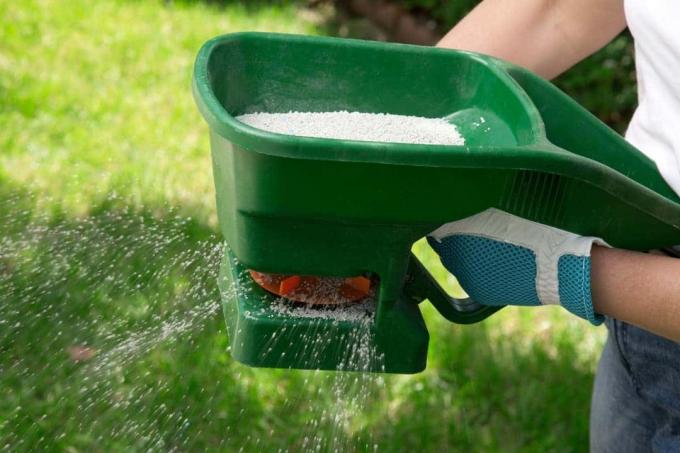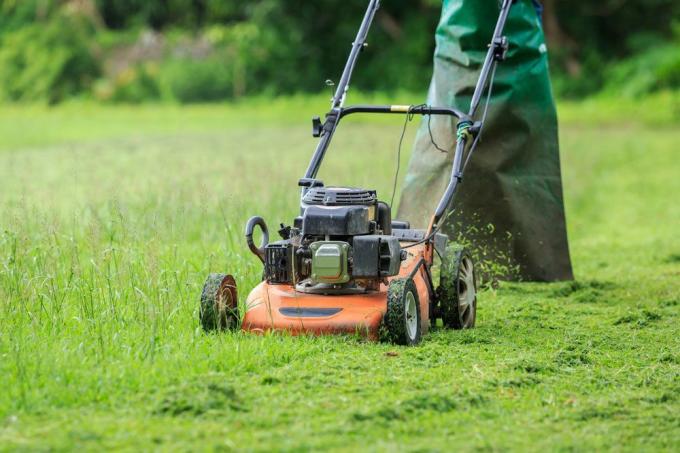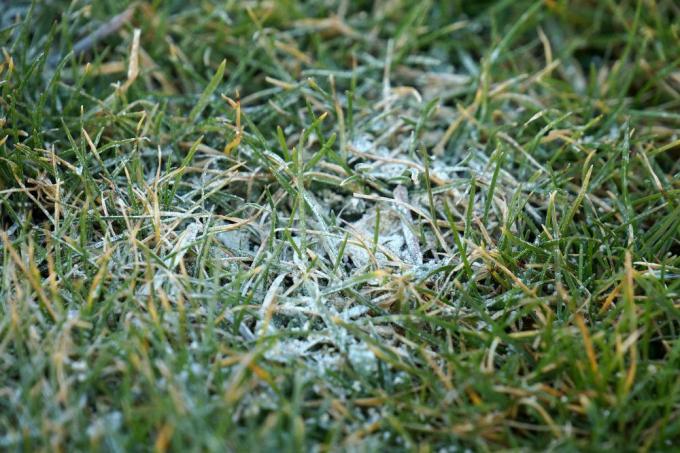
table of contents
- Lawn care in spring
- First fertilization
- First mowing
- Liming the ground
- Maintenance work in summer
- Second fertilization
- Regular cut
- Lawn care in autumn
- Last fertilization
- Cut for the last time
- frequently asked Questions
That a nice one race needs a lot of care is out of the question. It also depends on the correct sequence in lawn care. Errors in the maintenance measures can have fatal effects on the result.
In a nutshell
- Fertilize three to four times a year depending on the location
- Soil test recommended before fertilization
- Pay attention to the optimal length of the stalk when mowing
- Intervals depending on the seed and season
- Liming only as needed
Lawn care in spring
Lawn care goes through the whole gardening year. In addition to adequate watering and scarifying, the right time and the perfect amount for fertilizing, mowing and liming are crucial. The lawn care work begins in early spring.
First fertilization
Before you start fertilizing in spring, leaves and other plant residues must be removed from the lawn. If it is matted, the next thing is
Scarifying sensible. Then it is time for the first fertilization.- from the beginning to the middle of April
- provided that no more frosts are to be expected
- Seeds germinate when the outside temperature is at least 15 degrees
- Floor temperature at least 10 degrees
- not in rainy weather and in direct sunlight
- Give nitrogenous fertilizers with long-term effects
- let the grasses sprout more vigorously
- promote broad growth, make the grasses green
- Dosage according to the manufacturer's specifications

You can fertilize before or after mowing. If fertilization is carried out first, the fertilizer should already be drawn into the soil by the time it is mowed and not lie on the lawn. Otherwise the fertilizer granules could get caught in the long blades of grass and stick to them when wet. This, in turn, can clog the lawnmower. If you want to avoid this, you should change the order and first reach for the lawn mower and fertilize about three days later.
Tip: If the lawn is newly sown, you should wait until the grasses sprout out of the ground before applying the first fertilizer.
First mowing
mowing is another important part of lawn care and a prerequisite for a beautiful, dense lawn. Once the lawn begins to grow, it must be mowed regularly. This is the only way to develop a dense sward. After fertilizing, you should give the lawn some rest. As soon as the grass has reached a height of around seven centimeters, it is time for the first cut.
- Remove leaves and plant residues from the lawn
- optimal cutting height at four to five centimeters
- don't cut too short
- Weeds and wild growth can spread
- Increased risk of brown spots

The frequency of mowing depends on the season, because the lawn grows much faster in spring than in autumn. The next cut should be made at the latest when the stalk length is seven to eight centimeters and the clippings removed from the lawn after mowing.
Liming the ground
Liming only needs to be done if the pH value is well below 5.5. It is best to test the soil before applying lime. Hardware stores offer appropriate test sets. Usually it is enough to change the soil every three to four years lime to feed.
- best time in spring
- Liming is also possible in autumn
- in October at the latest
- Soil should be dry, scarify beforehand
- Apply lime in the appropriate dosage
- with spreader or by hand (gloves)
- then water well
- then let it rest for four weeks

The sequence between liming and fertilization does not matter, as long as you take a break of at least two weeks when maintaining the lawn. So that the fertilizer granulate can be completely released.
Tip: In general, lawns need a slightly acidic environment, deshalb shouldn't be limed too much.
Maintenance work in summer
In the hot season, when the sun shines on the green, it is important not to make any mistakes in the order of lawn care.
Second fertilization
The second follows at the beginning of summer in June fertilization, now the grasses grow the strongest. This fertilization is about strengthening the resistance of the lawn grasses in order to protect them from damage caused by heat and drought.
- balance between nitrogen and potassium is important
- Long-term lawn fertilizer especially for summer fertilization
- provide lawns with nutrients over several weeks
- regulate the water balance
- improve the resistance of lawn grasses
- with heavy use, if necessary, another fertilization in August

Tip: If you use mulching mowers or robotic lawnmowers, you usually need less fertilization. The chopped clippings remain on the surface and are used as fertilizer.
Regular cut
Cutting the lawn too short can also have devastating consequences for lawn care in summer. Persistent drought, especially in July and August, as well as intense sunlight would burn the lawn. Accordingly, the grass should now be about one centimeter longer than in spring, i.e. approx. five centimeters. In summer, mowing takes place around once a week, ideally in the cooler evening hours, so the grasses can absorb the water better.
Tip: High quality Lawn seeds grow an average of 2.5 cm per week and so-called cheap seeds 3.6 cm.
Lawn care in autumn
Even towards the end of the year there are a few things to consider in the order of the lawn care measures in order to prepare the green for winter.
Last fertilization
Now the last fertilization takes place. In contrast to spring, it should be potassium-accentuated. Potassium strengthens the plant tissue and makes the grass more robust and resistant for the winter. This fertilization should not be done too late. Because as soon as the temperatures drop below new degrees and there is no more growth, the grasses can fertilizer no longer record. It is best to fertilize between the end of August and October.

Cut for the last time
The last cut in autumn should be done before the first frost, before the soil temperature drops below nine degrees. The ideal straw length is approx. five centimeters. If the cut is shorter, the frost can more easily penetrate the soil and damage the roots of the grass. If they are too long, however, they can be pushed to the ground by snow, which increases the risk of fungal infections.
Tip: If necessary, the soil can be limed again in autumn.
frequently asked Questions
In general, you should only use special lawn fertilizers for lawn care, because they are tailored to the needs of the grass. Mineral fertilizers are directly available for the grasses, but should be dosed a little lower to avoid over-fertilization. Organic fertilizers are more recommendable due to their natural long-term effect, overfertilization is hardly possible here.
This is quite possible, especially if these plants are dependent on acidic soil such as B. Blueberries or other bog plants. It is best to find out before planting which plants could be affected in which form.
The amount of lime depends on the pH value or the type of soil. It can vary between 150-200 g / m² on sandy soils, 300-400 g / m² on loamy-sandy and 350-450 g / m² on loamy and clay soils. In order to apply the correct amount, precise knowledge of the nature of the soil is important. Too much lime when caring for the lawn can do a lot of damage.
